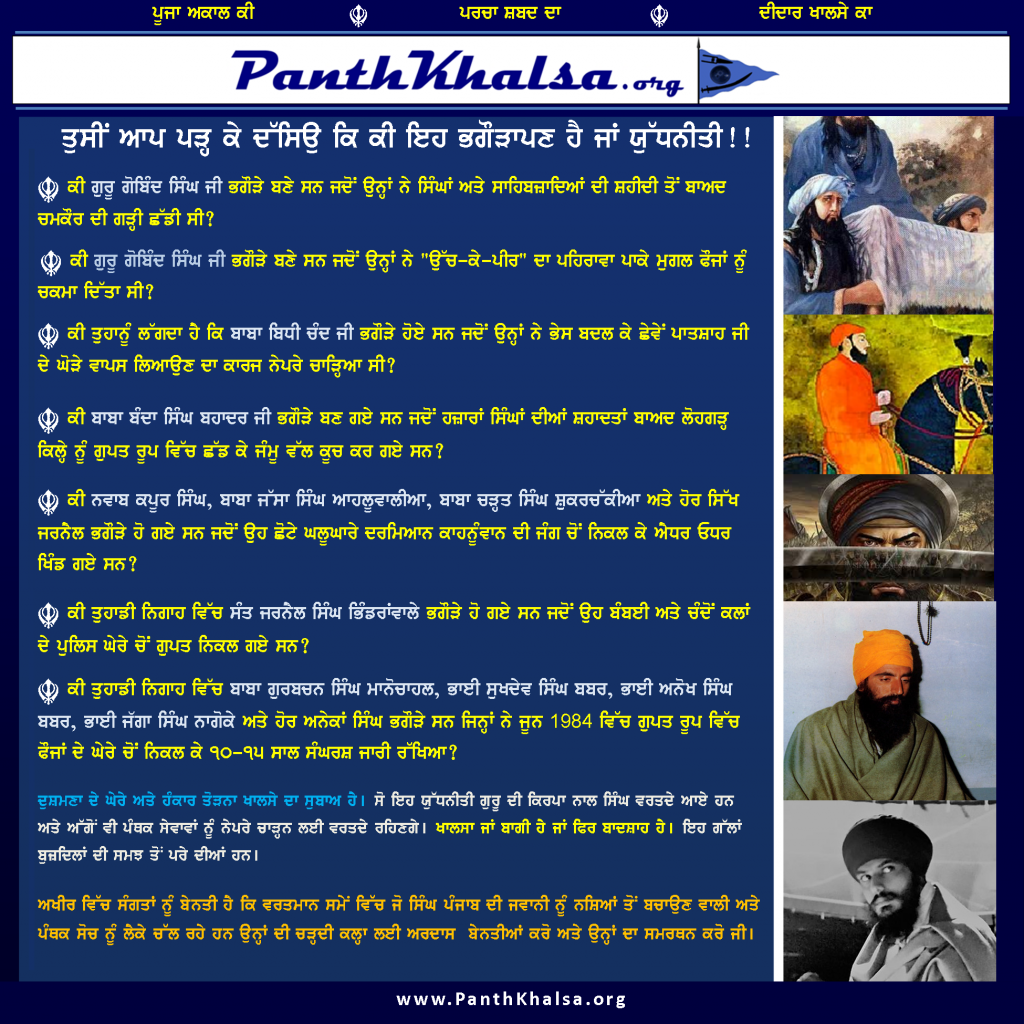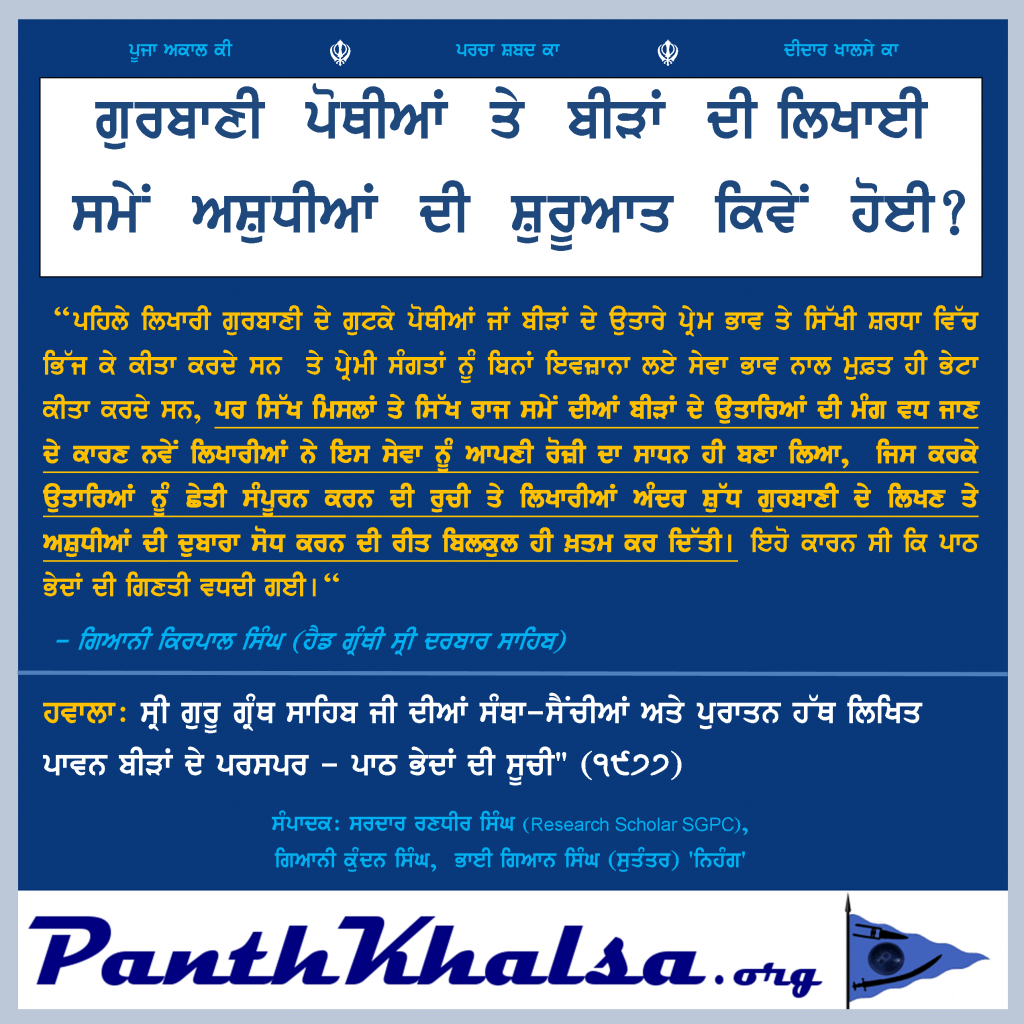An in-depth analysis regarding the placement of mangals in Sri Guru Granth Sahib Ji’s Bani by the late Bhai Kulbir Singh Ji (GurmatBibek.com)
ਸ੍ਰੀਅਕਾਲਸਹਾਇ॥
Definition of Problem: In current printed Saroops of Siri Guru Granth Sahib jee, there is no consistency as far as the headings (Sirlekhs) are concerned. In some places the Mangals appear first and at other places the Sirlekhs (e.g. Gauri Mahalla 5) appear first. In Shudh old handwritten Birs, the Mangals always appeared first. When SGPC first started printing Maharaj jee’s Saroops, Mangals always appeared in the beginning. But in the mid of 20th century, under pressure, the SGPC started printing Saroops where Mangals neither consistently appear in the beginning nor after the Sirlekh. A scholar out of frustration wrote to SGPC to bring consistency in the name of God and asked them to either let Mangals always appear in the beginning or always after but the current position of having the Mangals sometimes in the beginning and at other times after, was unbearable. This article has been written to bring awareness about Mangal Prabandh in Gurbani and to educate the Sikhs to understand the problem regarding Mangals and to inspire and prompt them to do Paath in the correct way i.e. by pronouncing Mangals in the beginning.
It’s long been a tradition to write in praise of the Deity before beginning to write. In olden days, even before writing a letter, Gursikhs used to write Manglacharan like Akal Sahai, Vaheguru jee kee Fateh etc. Now a days, this tradition has been totally lost. We write so many posts and emails but hardly write any Mangal in the beginning. In a way, the Fateh of Khalsa can be classified as a Mangal because we invoke our Deity – Vaheguru – through it.
Mangal is also called Manglacharan, Mangalcharan and Manglachaar. Vedas have used the Mangal OM and Quran Shareef has used Bismillah-ur-Rehmaan-u-Raheem. Even Waris Shah before writing his epic composition – Heer – wrote a Mangal about Khuda and Mohammad Sahib – Pehla Aap Khuda ne Ishq keeta, tey Pyaar hai Nabi Rasool Miyaan (ਪਹਿਲਾ ਆਪ ਖੁਦਾ ਨੇ ਇਸ਼ਕ ਕੀਤਾ, ਤੇ ਪਿਆਰ ਹੈ ਨਬੀ ਰਸੂਲ ਮੀਆਂ).
Types of Mangals
Scholars have classified Mangals into three types:
Vastu-Nirdeshatmik (ਵਸਤੁ—ਨਿਰਦੇਸ਼ਾਤਮਿਕ) – As the name implies this Manglacharan describes the qualities and nature of the Deity. Iੴ ਸਤਿਗੁਰਪ੍ਰਸਾਦਿ॥ is an example of this kind of Mangal. The Mool Mantra too is an example of this type of Mangal.
Asheervaadaatmik (ਅਸ਼ੀਰਵਾਦਾਤਮਿਕ ) – As per the name, through this Manglacharan the seeker seeks blessings (Asheervaad) of the Deity. Vaheguru jee kee Fateh or Jai Teghan are example of this type of Mangal.
Namaskaaratmak (ਨਮਸਕਾਰਾਤਮਕ) – As the name implies, through this Mangal, the seeker does Namaskaar to his Deity e.g. Pranvo Aad Ikankaara etc.
Many times, a combination of Mangals is used but the Vastu-Nirdeshaatmak Mangal is always used first. In Siri Bavan Akhri, the starting Salok (Gurdev Maata, Gurdev Pita) is an example of Namaskaratmak Mangal but this Mangal appears after the Vastu-Nirdeshatmak Mangal – ੴ ਸਤਿਗੁਰਪ੍ਰਸਾਦਿ॥.
In Zafarnama, Siri Guru Gobind Singh jee Maharaj used the Aad Mangal as – Ikoankaar, followed by Asheervaatkam Mangal – Hukam-Sat, Sri Vaheguru jee kee Fateh (ੴਸ੍ਰੀਵਾਹਿਗੁਰੂਜੀਕੀਫਤੇਹੈ॥).
After that, Siri Guru jee composed 12 Shayers (a salok-like poetic composition) as part of the Namaskaratmak Mangal. In the 13th Shayer, Siri Guru jee began the subject of his letter, with the heading “Dastaan”. Dastaan means story or subject matter.
In Siri Guru Granth Sahib jee, the Vastu-Nirdeshatmak Mangal has been used extensively.
The following 4 Vastu-Nirdeshatmak Mangals have been used in Gurbani:
ੴ ਸਤਿਨਾਮੁਕਰਤਾਪੁਰਖੁਨਿਰਭਉਨਿਰਵੈਰੁ
ਅਕਾਲਮੂਰਤਿਅਜੂਨੀਸੈਭੰਗੁਰਪ੍ਰਸਾਦਿ॥
ੴ ਸਤਿਨਾਮੁਕਰਤਾਪੁਰਖੁਗੁਰਪ੍ਰਸਾਦਿ॥
ੴ ਸਤਿਨਾਮੁਗੁਰਪ੍ਰਸਾਦਿ॥
ੴ ਸਤਿਗੁਰਪ੍ਰਸਾਦਿ॥
In Dasam Granth, the following 7 type of Mangals have been used:
ੴ
ੴ ਸਤਿਗੁਰਪ੍ਰਸਾਦਿ॥
ੴਸ੍ਰੀਵਾਹਿਗੁਰੂਜੀਕੀਫਤੇਹੈ॥
ੴਸ੍ਰੀਜੀਕੀਫਤਹੇ॥
ੴਹੁਕਮਸਤਿਸ੍ਰੀਵਾਹਿਗੁਰੂਜੀਕੀਫਤੇਹ॥
ੴਵਾਹਿਗੁਰੂਜੀ॥
ੴਵਾਹਿਗੁਰੂਜੀਕੀਫਤੇ, ਵਾਹਿਗੁਰੂਜੀਕੀਫਤਹ॥
Apart from this, there are other Mangals e.g. ਸ੍ਰੀਭਗਉਤੀਜੀਸਹਾਇ ।, ਸ੍ਰੀਅਕਾਲਸਹਾਇ ।
Place of Mangals – Aad Bir and other Birs of this style
As stated before, the Nirdeshaatmak Mangal or the basic Mangal which is also called Mool Mantra in Panth is always placed in the beginning of all.
In the Aad Bir (original Bir compiled by Siri Guru Arjun Dev jee) and other Birs of this order, the Mangals were always placed either on the top right side of the Ang (Panna) or on equal level with the Sirlekh, but again on the right hand side. The Mangals were kept on the right hand side out of respect. Below are some examples of how Mangals appeared in the Aad-Bir:
……………………………………………………………………………………….ੴ ਸਤਿਨਾਮੁਕਰਤਾਪੁਰਖੁਨਿਰਭਉ
……………………………………………………………………………………….ਨਿਰਵੈਰੁਅਕਾਲਮੂਰਤਿਅਜੂਨੀ
ਰਾਗਬਿਹਾਗੜਾਚਉਪਦੇਮਹਲਾ ੫ ਘਰੁ ੨…………………………………………………..ਸੈਭੰਗੁਰਪ੍ਰਸਾਦਿ॥
Now a days, the above stated Mangal apears in the printed Saroops of Siri Guru Granth Sahib jee in correct way, i.e. the Mangal appears first and the Sirlekh appears afterwards, even though the last line is shared by both Sirlekh and the Mangal.
Let’s look at another example:
ਰਾਗੁਗਉੜੀਅਸਟਪਦੀਆ ……………………………………ੴ ਸਤਿਨਾਮੁਕਰਤਾਪੁਰਖੁਗੁਰਪ੍ਰਸਾਦਿ॥
ਮਹਲਾ ੧ ਗਉੜੀ ਗੁਆਰੇਰੇ॥
Here the Mangal appears on the right handside out of respect and as it can be seen, the Sirlekh starts in the same line but ends in the second line. The Sirlekh does not go to the right handside and stays on the left handside. If we were to read this without using Bibek-Budh, we would read it as follows:
ਰਾਗੁਗਉੜੀਅਸਟਪਦੀਆ ੴ ਸਤਿਨਾਮੁਕਰਤਾਪੁਰਖੁਗੁਰਪ੍ਰਸਾਦਿ॥ ਮਹਲਾ ੧ ਗਉੜੀ ਗੁਆਰੇਰੇ॥
We know that no one reads it like that. The current printed Saroops have the above Sirlekh as follows:
ਰਾਗੁ ਗਉੜੀ ਅਸਟਪਦੀਆ ਮਹਲਾ ੧ ਗਉੜੀ ਗੁਆਰੇਰੀ ੴ ਸਤਿਨਾਮੁ ਕਰਤਾ ਪੁਰਖੁ ਗੁਰ ਪ੍ਰਸਾਦਿ ॥
The question is, how did the Mangal come after the Sirlekh when clearly the second line of this Sirlekh is one line below the Mangal? This proves that in the current printed Saroops, the Mangals and Sirlekhs are all mixed up. Guru Sahib Kirpa Karan.
Now let’s look at an example from Siri Sukhmani Sahib. In Aad-Bir, the beginning of Siri Sukhmani Sahib is written as follows:
ਗਉੜੀ ਸੁਖਮਨੀ ਮ: ੫ ॥ ਸਲੋਕੁ ॥ ੴ ਸਤਿਗੁਰ ਪ੍ਰਸਾਦਿ ॥
The Mangal was clearly on the right handside which meant that it should have been read first but now with the printed Gutka Sahibaan, it appears after the Salok, and everyone is reading it after the Salok, which is totally wrong. Here’s what it means, if we read the Mangal after the Salok:
• Since it appears after ‘Salok’ it means that the Manglacharan is part of the Salok.
• Since it appears after the ‘Mahalla’ heading, it means that it is baani of Guru Arjun Dev jee.
• Since it appears after the Raag heading it means that it is part of Raag Gauri.
None of the above statements is true.
Place of Mangals – Second Type
When some professional writers who were writing Maharaj jee’s Saroops as a profession and did not have full knowledge of Gurmat traditions, started writing the Saroops of Maharaj, they started writing Mangals sometimes after and sometimes before the Sirlekh. They did not understand the style of Aad Bir and did not realize that the Mangals were appearing on the right hand side out of respect and they ought to be pronounced first. Such writers at many places clearly wrote Mangals afterwards and then whoever copied from their Birs, did the same thing. This way, this confusion about Mangals started.
Place of Mangals – Third Type
When Gurmukh writers saw the error of writing Mangals after the Sirlekh, they abandoned writing the Mangal on the right handside and clearly started writing the Mangals on top and in the beginning. They wanted to avoid people getting confused. Principal Harbhajan Singh jee has written that in the Sikh Reference Library, there were hundreds of such handwritten Birs that always had the Mangals in the beginning. Many of these Birs got lost or Shaheed during the 1984 Saka.
Bhai Hardas jee, the Hazoori Likhaari of Siri Guru Gobind Singh jee
Bhai Hardaas jee was one of the 4 main Hazoori Likhaaris of Siri Dasmesh jee and the Bir written by him, which was safe in the Sikh Reference Library up until 1984, is considered to be one of the most Shudh handwritten Saroop of Guru Sahib. This Bir not only contained all the Mangals in the beginning but also had all Baani of Siri Guru Tegh Bahadur Sahib jee at the correct places in Raags. This proves that Siri Guru Tegh Bahadur Sahib jee’s baani was added to the Bir, before Guru Sahib left Siri Anandpur Sahib. In any case, this is a separate subject that has no relevance here.
In the end of this Bir written by Bhai Hardaas jee, the following words appear, that show the Avastha and humility of Bhai Sahib:
ਗ੍ਰੰਥ ਸੰਪਰੂਨ ਹੋਆ, ਲਿਖਿਆ ਹਰਿਦਾਸ ਲਿਖਾਰੀ, ਸ੍ਰੀ ਗੁਰੂ ਗੋਬਿੰਦ ਸਿੰਘ ਜੀ ਦੇ ਲਿਖਾਰੀ ਲਿਖਿਆ। ਭੁਲ ਚੁਕ ਹੋਵੇ ਸੋ ਸੋਧਨਾ, ਗੁਲਾਮ, ਪਤਿਤੁ, ਅਘ ਪਤਿਤੁ ਮਹਾਂ, ਪਤਤ ਹਰਿਦਾਸ ਲਿਖਾਰੀ ਸ੍ਰੀ ਗੁਰੂ ਗੋਬਿੰਦ ਸਿੰਘ ਜੀ ਦਾ।
It bring tears to your eyes reading the above words of Bhai Hardaas jee. He did such great Sewa; he was the Hazoori Likhaari of Siri Guru Gobind Singh jee, and yet how humble he was. Such humility can be found only in Gursikhs. Another thing to note is that while he seems very humble but when he writes that he is the Hazoori Likhaari of Guru Gobind Singh jee (he writes this two times) one can feel the Gurmukhi pride in that. What a great title to have – Hazoori Likhaari of Siri Guru Gobind Singh jee. Vaah!! Vaah!!
Another one of Guru Sahib’s Hazoori Likhaari was Bhai Paakhar Mal Dhillon, who was the grandson of legendary Gursikh of Siri Guru Arjun Dev jee – Chaudhari Langah.
A Thought-Provoking Observation
In Kartarpuri Bir, at some places a very interesting observation has been brought up which proves that Mangals were written first on the right handside and then the Sirlekhs were written on the left handside.
……………………………… ਆ
ਸਿਰੀਰਾਗੁ ਮਹਲਾ ੩ ਘਰੁ ੧ ਅਸਟਪਦੀ ੴ ਸਤਿਗੁਰ ਪ੍ਰਸਾਦਿ ॥
The “ਆ“ had to be written above the line. Why? Because Mangal was written first and then when they started writing the Sirlekh from the left side, shortage of space was felt, and therefore, the “ਆ“ was written above the line. If the Sirlekh had been written first, then such problem would not have arised.
Have a look at another example:
ਰਾਗੁ ਗਉੜੀ ਪੂਰਬੀ ਮਹਲਾ ੴ ਸਤਿਗੁਰ ਪ੍ਰਸਾਦਿ ॥
……………… .੫
In the above example, the number of Mahalla i.e. ੫ is written below the line. Why? Because the Sirlekh was written afterwards and the Mangal was written first on the right hand side. If the Sirlekh had been written first, then there would have been no problem of writing “ ੫ “ in the same line.
Please ponder upon another example, that makes this concept of writing the Mangal on the right hand side, first, even more clear:
ਗਉੜੀ ਕੀ ਵਾਰ ਮਹਲਾ ੫ ਰਾਇ ਕਮਾਲਦੀ ਮੋਜ ੴ ਸਤਿਗੁਰ ਪ੍ਰਸਾਦਿ ॥
ਦੀ ਕੀ ਵਾਰ ਕੀ ਧੁਨਿ ਉਪਰਿ ਗਾਵਣੀ
ਮੋਜਦੀ above is one word but since the Manglacharan was written first on the right hand side, there was no room to even accommodate “ਦੀ” and this resulted in moving the latter part to the next line. Now a days, the printed Saroops have placed the Mangal after the Sirlekh. This is so wrong. Maharaj Kirpa Karan.
In the light of the above three examples, it becomes abundantly clear that the Mangals were always written first and were written on the right hand side. Many times the Mangals were written on right hand side, a little above but many times they were written in the same line as the Sirlekh.
Manglacharan is Moolmantra
One of the names of Manglacharan is Mool Mantra. The meaning of Mool Mantra is – Root Mantra. Since Mangal is the Mool, it should always be written in the beginning, and never after. How can the Mool of Gurbani be written afterwards? Vaheguru is Sabh tau Pehla and therefore the Mangal or Mool Mantra defining Vaheguru has to be written in the beginning. How can it be written after the Raag or Mahalla? It is an insult to Mool Mantra and Vaheguru to write it after the Raag.
Is Moolmantra (or other Mangals) Baani of Bhagats?
It’s a universally accepted that the Mool Mantra or the Manglacharan was given to us by Siri Guru Nanak Dev jee. Also, this is universally accepted by all that the Sirlekh gives certain information that we are obligated as Sikhs of Guru Sahib, to believe and have faith in. If the Sirlekh says “ਗਉੜੀ ਪੂਰਬੀ ਮਹਲਾ ੫”, then it clearly means that from hereon, the Baani is written in Raag Gauri-Poorbi and has been written by Mahalla 5 i.e. Siri Guru Arjun Dev jee. A Gursikh cannot question this Hukam of Guru Sahib and must obey it. Similarly, if the Sirlekh says Baani Bhagta kee, it means that the Baani after this Sirlekh is of Bhagat Sahibaan. In the light of this information, let’s look at this heading on Ang 93:
ਸ੍ਰੀਰਾਗ ਬਾਣੀ ਭਗਤ ਬੇਣੀ ਜੀਉ ਕੀ ॥ ਪਹਰਿਆ ਕੈ ਘਰਿ ਗਾਵਣਾ ॥ ੴ ਸਤਿਗੁਰ ਪ੍ਰਸਾਦਿ ॥
Based on the above Hukam in the Sirlekh, the following information is derived:
1. The Baani appearing next is in Raag Sri Raag.
2. The author of the Baani is Bhagat Beni.
3. This Baani is to be sung in the same Ghar as the Pehre (name of a Baani).
4. The Mangal ੴ ਸਤਿਗੁਰ ਪ੍ਰਸਾਦਿ ॥ is the composition of Bhagat Beni.
The first 3 points listed above are just fine but the last point shows such a big blunder. We all know that the Mangal is not the composition of Bhagat Beni jee but we have to obey the Hukam given in the Sirlekh and believe that this Mangal is the composition of Bhagat jee. Please think rationally and not emotionally. When we think with Bibek Budh, we can’t help realizing that the Mangal here should have appeared in the beginning. It is certainly an error thanks to obliviousness of SGPC.
Another thing to note is that while the Baani was written by the Bhagat Sahibaan, but none of the Bhagat Sahibaan wrote any Mangals. The Mangals and the Sirlekhs were added by Guru Sahibaan. So how can the Mangals appear after the Sirlekhs declaring Bhagat Baani?
Brahmgyaani Shaheed Bhai Mani Singh jee’s views on Manglacharan
ੴ ਸਤਿਨਾਮੁਕਰਤਾਪੁਰਖੁਨਿਰਭਉਨਿਰਵੈਰੁ
ਅਕਾਲਮੂਰਤਿਅਜੂਨੀਸੈਭੰਗੁਰਪ੍ਰਸਾਦਿ॥
ਨਾਮ ਸਭ ਦੇਵਾਂ ਦਾ ਦੇਵ ਹੈ। ਕੋਈ ਦੇਵੀ ਨੂੰ ਮਨਾਵਦਾ ਹੈ। ਕੋਈ ਸ਼ਿਵ ਨੂੰ, ਕੋਈ ਗਣੇਸ਼ ਨੂੰ, ਕੋਈ ਹੋਰ ਦੇਵਤਿਆਂ ਨੂੰ। ਗੁਰੂ ਕੇ ਸਿਖ ਸਤਿਨਾਮੁ ਨੂੰ ਅਰਾਧਤੇ ਹੈਂ ਜਿਸ ਕਰ ਸਭ ਵਿਘਨ ਨਾਸ ਹੋਂਦੇ ਹਨ। ਤਾਂ ਤੇ ਸਤਿਨਾਮ ਦਾ ਮੰਗਲਚਾਰ ਆਦਿ ਰਖਾ ਗਿਆ ਹੈ।
In the above writing of Bhai Mani Singh jee from Janamsakhi Bhai Mani Singh waali, clearly proves that Mangal should be kept in the beginning. Bhai Sahib gives the argument that since Satnam destroys all problems and since Gursikhs worship Satnam, for this reason the Mangalchar of this Satnam i.e. the Mool Mantra has been kept in the beginning.
Conclusion
The conclusion of the above Vichaar is that the Manglacharan should be pronounced before the Sirlekh. The purpose of this article is not to start an argument or an anti-Gurmat debate but the purpose is to inform Gursikhs about the correct way of pronouncing Mangals. Bhai Sahib Randhir Singh jee and numerous other Gurmukhs favoured the Mangals in the beginning. The Shiromini Committee published Birs in the beginning of the last century and all of them had Mangals in the beginning. Two such Birs published by SGPC are currently in Toronto and numerous others can be found in different parts of the world.
It’s quite unfortunate that some Premis don’t want to listen to anyone else but just insist that whatever their Mahapurakhs have said must be followed by all. All Gurmukhs Mahapurakhs are worthy of our utmost respect but we must not forget that Gurbani says that with the exception of Vaheguru and Satguru, everyone else makes mistakes. No one person, group, jatha is bigger than Gurmat. Gurmat must prevail, at all costs.
Guru Sahib knows better and may Guru Sahib enable us to follow Gurmat.
Bhul Chuk dee Maafi jee.
Daas,
Kulbir Singh
Source: Detailed Vichaar on Mangal Prabandh of Gurbani (gurmatbibek.com)
References: Books of Professor Sahib Singh, Giani Harbans Singh, Principal Harbhajan Singh, Mahankosh of Bhai Kahn Singh Nabha, Bhai Vir Singh and Vichaars with numerous Gursikhs.







